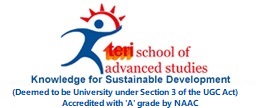
ANNOUNCEMENTS

| Date | News Title | Source |
| 18-July-2025 | 1 in 4 Indian married couples ... | The Indian Express |
| 23-June-2025 | Blended Learning: Driving educ... | The Pioneer |
| 22-June-2025 | All adults overweight in every... | |
| 21-June-2025 | TERI SAS Nurturing Global Sust... | The Interview World (Online) |
| 27-May-2025 | Eco-education trend grows: Sus... | India Today (Online- Education Desk) |
| 25-March-2025 | How water green credits can fu... | Hindustan Times (Opinion) |
| 23-February-2025 | Sustainable biz practices disc... | The Times of India (Online) |
| 21-February-2025 | Sangam fit for bath’, Enviro... | News9 (Online) |
| 12-February-2025 | A role for India in South-Sout... | The Hindu (Online) |
| 02-December-2024 | ICAR Findings Show 34% Decline... | ETV Bharat (Online) |
Construction of a dam near the Najafgarh drain to prevent flooding has been a longstanding demand of farmers in the area. In 2019, farmers wrote to the state human rights commission, demanding the construction of a check dam and compensation for losses due to flooding.
Even as the Haryana government is yet to submit an environment management plan pertaining to the Najafgarh lake with the National Green Tribunal (NGT), chief minister Manohar Lal Khattar on Monday said that the government is considering construction of check dams (bundhs) around the lake to prevent flooding of around 5,000 acres of agricultural land located in its vicinity.
Stating that he was aware of the problems faced by villagers, Khattar said, “Activities are ongoing at the state level to resolve the issue. The deputy commissioner has submitted the report to the state wetland authority. Under this, technical and financial subcommittees have been formed. Also, the plan is to build a dam on the slope side of the lake to stop water from inundating the agricultural land.”
Khattar was in the city to attend the monthly grievance redressal meeting where the issue was raised by the Badshahpur member of the legislative assembly (MLA) Rakesh Daulatabad.
Construction of a dam near the Najafgarh drain to prevent flooding has been a longstanding demand of farmers in the area. In 2019, farmers wrote to the state human rights commission, demanding the construction of a check dam and compensation for losses due to flooding.
On June 17 this year, the principal bench of the NGT asked the Haryana government to submit an environment management plan (EMP), which has been pending for the past 10 months. The next hearing is scheduled for October 10.
Since sewage water from nearby villages is also drained in the area, the CM said that daily-use water from Dharampur village has to be processed by a sewage treatment plant before it is discharged.
According to the district administration officials, sewer lines from Dharampur village will be connected to Jahajgarh village, where an STP of 20 MLD capacity is being constructed and will be functional by March 2022.
However, experts were against the construction of a check dam at Najafgarh.
Ritu Rao, a PhD scholar at the TERI School of Advanced Studies, who specialises and works on urban water bodies and has been working on the Najafgarh lake, said, “Building a check dam near the lake will block the only outlet for stormwater in Gurugram. With climate change, Gurugram is facing extreme precipitation in a short span of time, which leads to urban flooding; this will only increase in future. Further, to build a check dam, undulated terrain is needed, whereas the area in question is not such a land.”
The seven-square kilometre Najafgarh Jheel is an important water body for Gurugram as it acts as a large aquifer to recharge groundwater. Many creeks in the Aravallis flow into the Najafgarh Jheel, which is further carried to the Yamuna. The lake is located in a natural depression in southwest Delhi, close to the Gurugram-Rajokri border on National Highway-48. It is fed by the Najafgarh drain, which has a sizeable catchment area in Gurugram. A portion of the lake falls in Haryana.
The Haryana government is yet to submit an environmental management plan for the lake, giving details of how the area along with its ecology will be protected. The Delhi government, in the last hearing, had submitted a draft EMP to the NGT.
Experts working for the protection of the lake have been demanding that the Haryana government declare the water body a wetland till 212.5 metres above mean sea level, in accordance with the high flood level of the past 100 years. If it is done lower than that, then there is a risk of flooding and collapse of the buildings constructed on this land as the Najafgarh Jheel is a natural hazard zone.
CM IN CITY
Besides the Najafgarh issue, at least 12 other complaints were placed before the CM, including issues pertaining to the ongoing construction work at Atul Kataria crossing that is likely to be completed by November 30, availability of differential global positioning system machines to measure land and encroachment of land in villages.
Over 33 complaints were to be placed before the CM, of which at least 20 complaints were resolved before the grievance meeting.
Khattar, on Monday, also inaugurated the drinking water supply project set up for sectors 81 to 99. The project is a part of the Gurugram Metropolitan Development Authority’s (GMDA) three-phase plan to lay water pipelines in newer sectors, 58 to 115, at a cost of ?235 crore. Officials said that the first phase was constructed at a cost of ?76.21 crore and it will cater to around 380,000 people.
Giving a presentation to the CM, GMDA chairman Sudhir Rajpal said that at least 229 water licences have been issued in these sectors. Among them, 56 licensees have received occupation certificates from the town and country planning department. Currently, these colonies are dependent on water tankers for their daily water requirement. He said that the department faced hurdles at 47 spots while laying the pipeline, according to the district administration statement.
Khattar also virtually inaugurated a waste-to-energy plant worth ?176.87 crores in Sonepat and Panipat. The project has been set up under a public-private partnership and will produce eight megawatts of electricity.
Plot No. 10, Institutional Area, Vasant Kunj, New Delhi - 110 070, India.
Tel. +91 11 71800222 (25 lines).
Website : www.terisas.ac.in
Email id : registrar@terisas.ac.in
© Copyright © 2025, TERI SAS, All rights reserved.
Visitors No.: 46541618 Since 2023


